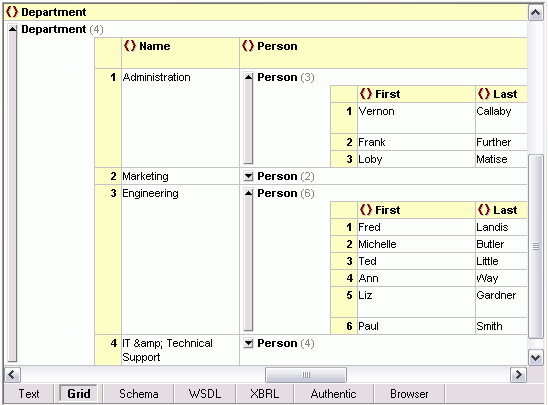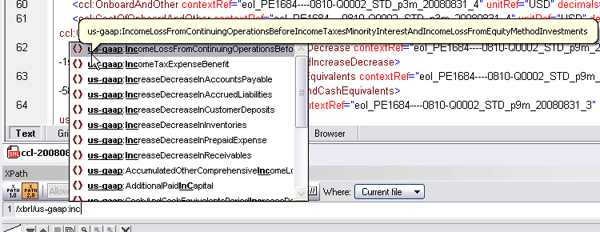Exploring Large XML/XBRL Documents with XMLSpy
Last week, while giving a demo of the new XBRL capabilities in the Altova MissionKit, we stumbled across an interesting question: What is the best way for a semi-technical SME (in this case a CPA) to navigate a large XML/XBRL document for data entry? XMLSpy, which is included in the MissionKit tool suite, has a lot of cool features and different views for XML data, including the ever-popular grid view for visualizing the hierarchical structure of an instance document in a graphical manner. The ability to easily expand and collapse containers and drag and drop to change position makes XMLSpy’s grid view a pretty good choice for the task.  Of course let’s not forget that the XMLSpy XML editor also has a Find feature that would enable users to simply press Ctrl F or use the Find in Files window to find any element that they are looking for… but alas, in the case of XBRL, where element names are mindbogglingly verbose, this may be a challenge. Consider, for example, the US-GAAP’s aptly named <us-gaap:IncomeLossFromContinuingOperationsBeforeIncomeTaxesMinorityInterestAnd IncomeLossFromEquityMethodInvestments>. Not so much fun to type into a Find dialog… Our solution, therefore, and the winner for the easiest and most comprehensive way for even a non-technical user to find XML elements in a large document, utilizes a combination of longstanding XMLSpy features (the XPath Analyzer window) and a new feature in XMLSpy v2009, XPath auto-completion. Simply begin typing the element name in the XPath Analyzer window, and XMLSpy will show you all of the possibilities. Next, choose the one you are looking for, and XMLSpy will navigate directly to that node in the XML document. Now that was easy! And better yet, you get to tell your friends that you know XPath.
Of course let’s not forget that the XMLSpy XML editor also has a Find feature that would enable users to simply press Ctrl F or use the Find in Files window to find any element that they are looking for… but alas, in the case of XBRL, where element names are mindbogglingly verbose, this may be a challenge. Consider, for example, the US-GAAP’s aptly named <us-gaap:IncomeLossFromContinuingOperationsBeforeIncomeTaxesMinorityInterestAnd IncomeLossFromEquityMethodInvestments>. Not so much fun to type into a Find dialog… Our solution, therefore, and the winner for the easiest and most comprehensive way for even a non-technical user to find XML elements in a large document, utilizes a combination of longstanding XMLSpy features (the XPath Analyzer window) and a new feature in XMLSpy v2009, XPath auto-completion. Simply begin typing the element name in the XPath Analyzer window, and XMLSpy will show you all of the possibilities. Next, choose the one you are looking for, and XMLSpy will navigate directly to that node in the XML document. Now that was easy! And better yet, you get to tell your friends that you know XPath. 

